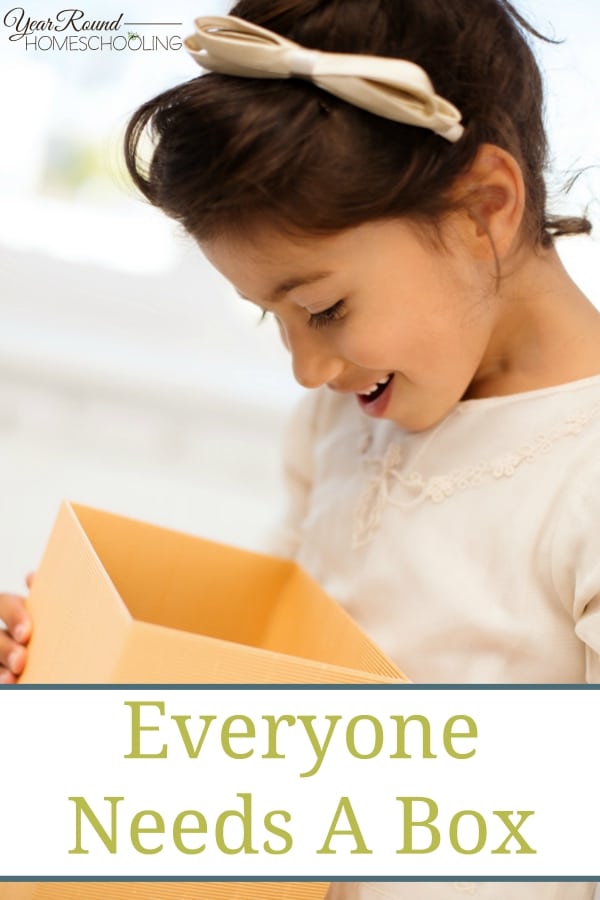I know you’ve heard the old saying, “Give the kid a new toy, but he’ll only play with the box.” Many parents find this frustrating, but I find it magnificent. Boxes are wonderful, fantastic things. They become anything your mind sees them to be. That’s the beauty of a child’s innocence, they see ragged boxes as castle forts protecting them from fire-breathing dragons, or when disassembled they become slides for the hall staircase (so glad my son didn’t think of that one–he would have tried it). Anyway you go, every kid needs a box or two to spur their imagination.

That’s where boxes can be sanity savers. These boxes don’t have to be large. They don’t have to be new. They don’t have to be hard plastic containers–shoe boxes work nicely! Still everyone needs a box. As part of your school year planning, plan for a “busy box” for every child in the family. These boxes can be made inexpensively with recycled items, or very lavishly with store-bought games and toys. For variety’s sake, some parents choose to create different busy boxes for each day of the week. The choice is yours. I prefer one simple recycled busy box per child for economic reasons. When you need to make three or four of these, it can get expensive even at the dollar store.
Using busy boxes in your homeschool
Busy boxes are a great way to keep kids busy and out of trouble after they finish their work before other siblings or on rainy days when you would normally hear things like “I’m bored”. You can use busy boxes to keep your kids busy and out of trouble. You can change what is offered in the busy boxes to go along with your unit studies or seasonal activities to keep them changing all year long so they help keep your child’s interest.
You can give each child a box of their own they can decorate and have fun with or make a few individual boxes that your kids can share going between them doing what interests them at the time. A combination of the two works really well for families.
When I am planning a new unit study I look for items and activities that I can put into busy boxes that help build onto what we are learning even if those are simply fitting the theme but, I really love educational activities that are truly part of the unit study for some individual work time.
Building busy boxes for your homeschool
Fill the boxes with items that will keep them busy for at least 15-20 minutes. This could be hard if you’re making a toddler or preschool box, so you may want to reduce the activity time. Whatever you put inside, make them simple items they enjoy using and won’t become frustrated with. Busy box time is a time for quiet play, but it doesn’t hurt to work on fine motor skills, math, or literacy. A few things I caution you against in young children’s busy boxes:
- Scissors
- Glue
- Markers
- Tiny items
These items can be choking hazards or make messes that leave you with more cleaning time than they are worth. My favorite items for toddlers and preschoolers are:
- Lacing cards you make with thin cardboard, a hole punch and yarn.
- Punching holes in the lid of an oatmeal container (or the like), then placing colored circles around those holes. The child then inserts a chenille stem of a matching color into the holes.
- Spoon matching–write the capital letters on clear plastic spoons, and lowercase on white plastic spoons, the child then matches the upper and lowercase letters by nesting the spoons.
- Any type of sorting or matching activity
For elementary I would add items like:
- Classic lego bin – This can be its own busy box or you could opt with mini-themed sets that can fit inside individual busy boxes.
- Scissors and line forms for cutting practice–make sure younger ones can’t get their hands on these.
- Maze books.
- Logic problem puzzle books.
- Origami patterns and paper for folding
- Craft items she enjoys, knitting, crocheting, etc
- Books or Kindle for reading
- Items that encourage your child’s hobbies
Keep in mind that not all busy box goodies will fit into a box. For ideas that don’t fit into a typical box try a basket or a shelf in your school room to hold busy activities for your kids. The overall point is to just gather items your kids can use to keep busy and out of trouble when they are waiting after they finish their work. This can be a great asset to help you make the most of your homeschool days.
Homeschool help is easy to find when you know where to look! Check out our homeschool help Pinterest board and find all the help you’ll need!
